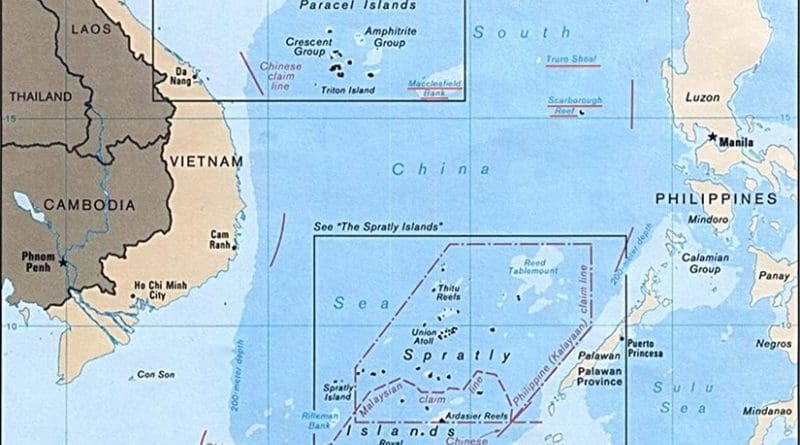ASEAN, China Agree To Talks On South China Sea Code
By RFA
China and ASEAN said they both agreed Sunday to a framework for talks on a “code of conduct” in the disputed South China Sea, but the Southeast Asian side indirectly criticized Beijing’s territorial expansion there in an unusual statement.
The foreign ministers of the 10-member Association of Southeast Asian Nations said they warmly welcomed “improving cooperation” with China and were encouraged “by the conclusion and adoption of the framework of a code of conduct in the South China Sea,” in a joint communique. They issued it late on Sunday evening (local time) after meeting with Beijing’s top diplomat in Manila during the day.
China and ASEAN will start negotiations later this year on a code of conduct governing actions in the disputed sea region after both sides agreed to a framework, Chinese Foreign Minister Wang Yi told reporters following the meeting, which was held behind closed doors.
In their communique the ASEAN ministers confirmed that the regional bloc was ready to begin “substantive” negotiations on a code of conduct.
But in an oblique reference to China’s efforts to expand in the potentially mineral-rich sea region – such as through building artificial islands, air strips and other installations – they also noted “concerns expressed by some Ministers on the land reclamations and activities in the area, which have eroded trust and confidence, increased tensions and may undermine peace, security and stability in the region.”
“We emphasized the importance of non-militarization and self-restraint in the conduct of all activities by claimants and all other states,” according to the short section on the South China Sea included in a 46-page communique.
China and Taiwan, as well as four members of ASEAN – the Philippines, Malaysia, Vietnam and Brunei – all have territorial claims in the sea, and overlapping claims have been a source of tensions. The sea is strategically important because it is home to a third of the world’s shipping lanes.
‘Positive momentum’
Wang Yi said the climate in 2017 between states that have claims to the sea region had improved and was more conducive to peace.
“The atmosphere of this year is different from the past,” Wang said. “China and ASEAN countries have been working together for the past year and we fully recognize that.”
“Thanks to our concerted efforts, the current situation in the South China Sea is showing positive momentum,” he said, adding that China and ASEAN recognized a current trend towards “relaxation” of tensions in the sea region.
When the situation in the South China Sea becomes “generally stable and if there no major disruption from outside parties,” both parties can then start their consultations in time for the ASEAN Leaders’ Summit in November, the Chinese foreign minister said.
“China and ASEAN have the ability and wisdom to work together to maintain regional peace and stability,” he said. “And we will work out regional rules that we mutually agreed upon so as to open up a bright future for our future relations.”
Before the ASEAN countries came out with their statement on the South China Sea, the 10 ministers were divided over the issue, according to reports.
The ministers had been debating for at least two days on how to respond to China collectively, with Vietnam said to be strongly resisting an agreement on the framework for a code of conduct as pushed by Beijing.
“There’s still no consensus,” a diplomat said earlier during the weekend, according to Agence France-Presse.
“Vietnam is adamant, and China is effectively using Cambodia to champion its interests. But the Philippines is trying very hard to broker compromise language.”
In past months, the Philippines had pushed for a code on the South China Sea to be legally binding, according to diplomatic sources.
Sino-Filipino relations over sea
The ASEAN-China meeting was part of a flurry of one-to-one meetings held Sunday between foreign ministers from the Southeast Asian bloc and top diplomats from other countries including Japan, the United States, India and Russia.
The meetings in Manila, hosted by the Philippines, this year’s holder of the ASEAN chair, took place on the eve of the ASEAN Regional Forum, an annual security meeting bringing together 27 countries.
Wang did not elaborate on to whom he referred as the “outside parties,” but his announcement came shortly after the U.S. Navy carried out “freedom of navigation” exercises near disputed islands, as it sought to counter-balance perceived Chinese bullying in the disputed area.
The current ASEAN chairman, Philippine President Rodrigo Duterte, has made it a priority to repair bilateral ties with China, which has rejected an international court’s ruling in 2016 that invalidated its claim to the entire sea region.
Duterte made a state visit to China last year, and also threatened to sever security cooperation with Beijing’s traditional rival, the United States.
In 2013, Duterte’s predecessor, Benigno Aquino III, took Beijing to the Permanent Court of Arbitration at The Hague after Chinese vessels were spotted in Scarborough Shoal, which had for years been a traditional fishing area for Filipinos.
The area consists of rocks and shoals and is only about 200 km (125 miles) from the main Philippine island of Luzon.
The court last year threw out China’s historical claims to the region. The court said that, in effect, no country had sovereign rights over the rocky outcrop, therefore entitling all countries with overlapping claims to use its resources.
The ruling angered China, putting the region on edge amid fears that it could force Beijing to retaliate militarily. Beijing since then has carried on with its expansionist moves in the sea region, and intelligence officials said it may be deploying weapons on the islands it occupies.
Following the court decision last year, Duterte himself said that he told Chinese leader Xi Jinping that he planned drilling explorations in the area. But he claimed that Xi threatened him with war if he went ahead with implementing those plans.
Reported by BenarNews, an RFA-affiliated online news service.

